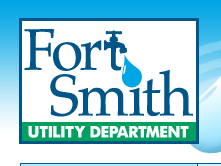|
Have you ever thought about where your
drinking water
comes from, beyond the faucet? We have!

Pictured: Lake Fort Smith Watershed
Did you know that what you do in and
around your home can
affect not only the quality of your water but also the quality
of your neighbor's water?
Safe drinking water is essential to a community's quality
of life and continued economic growth. Yet citizens may not
always be aware of safe drinking water issues in their community
and may not realize what needs to be done to protect drinking
water and keep it safe for their families and businesses.
Drinking water supplies across the country are being contaminated
daily by common activities, such as pouring motor oil and
household chemicals down drains, using too much pesticides
and fertilizers,
and littering streets with refuse that will eventually run
off into rivers
and streams. When water supplies are not safe, the health
of the
community - especially of the young, the old, and the sick
-
is jeopardized.
In addition, communities may experience a loss of tax revenues
from
real estate and new jobs as businesses refuse to locate to
or remain
in communities with known or suspected water contamination
problems.
Protecting drinking water sources is the first line of defense
in ensuring safe drinking water. If communities are aware
of their drinking water sources and of potential threats to
these sources and their watersheds, they can take steps to
keep the sources safe and improve their local environment.
There is something everyone - from retirees to school kids
to individuals in their homes - can do to help.
Why should watersheds matter to me?
While folks may not always realize it, they place a high
value on healthy watersheds. Without proper watershed management,
communities across the nation are experiencing similar problems,
including drinking water contamination, increased flooding,
and a loss of natural areas.
Since the beginning of time, a safe and dependable source
of water has been a major factor in where people settled.
Currently, humans depend on wells, springs, reservoirs, lakes,
streams and rivers for our ever-expanding need for water.
Once a water source is located, we usually do not question
its safety
and dependability. If the drinking water looks good, tastes
good and smells good, we assume it is safe to drink. Progress,
however, has
not left water in its natural state. In the last century,
both population
and business activity have exploded.
Yet there is no more fresh water today than there was a million
years ago. While 70 percent of the earth is covered with water,
97 percent is salt water. Of the three percent that is fresh
water, approximately two thirds is frozen and unavailable
for use.
Industry, agriculture and the growth of cities have all contributed
to greater use and greater contamination of water sources.
Many places
in this country face a critical water shortage, at the same
time that the quality of their water is at risk.
Until recently, public water systems have relied on testing
and treatment to provide safe drinking water. The passage
of the SDWA brings a new focus on prevention and protection.
Source water protection is the first line in preventing drinking
water contamination and the cornerstone of efforts to save
future costs in treatment and possible replacement of local
water supplies.
|





